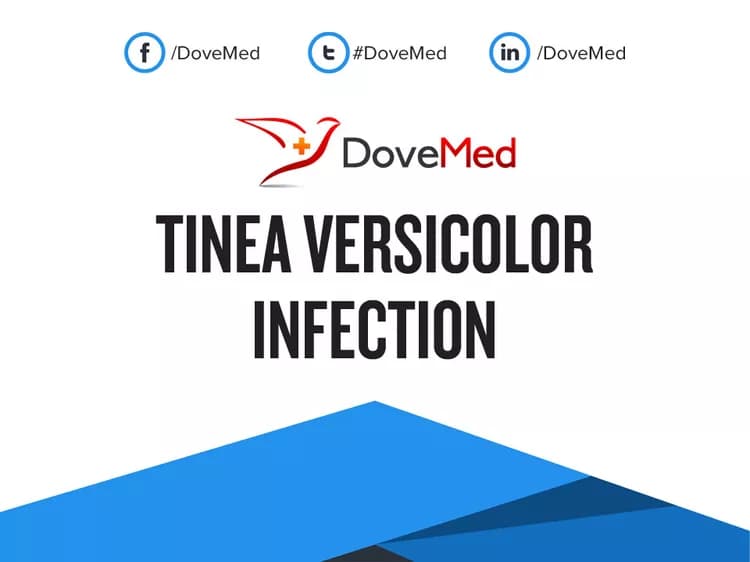What are the other Names for this Condition? (Also known as/Synonyms)
- PV (Pityriasis Versicolor) Infection
- Sun Fungus Infection
- TV (Tinea Versicolor) Infection
What is Tinea Versicolor Infection? (Definition/Background Information)
- Tinea Versicolor (TV) Infection is a fungal infection that affects the body skin surface, especially at the chest, back, arms, neck, and lower legs. The groups of fungus causing the infections belong to the genus Pityrosporum ovale and Malassezia globosa. Both of them are types of fungus, called yeast
- Itching sensations are felt on the skin with the appearance of discolored skin patches (which may be of darker or lighter color than the unaffected skin, or pink). Skin patches have a scaly textured surface and fine edges. The infection develops due to conditions intrinsic to the patient and prolonged periods of hot humid climatic conditions
- The causative organisms live in the sebaceous areas of most individuals following puberty. A higher number of organisms are seen in Tinea Versicolor
- Unlike other fungal skin infections, Tinea Versicolor Infection is non-contagious. It means that the infection cannot spread from one individual to another individual. Though, it may affect any individual, adolescents and young adults are affected the most
- It is very common throughout the tropical and subtropical geographical regions. It is also common in the temperate areas of the world. The condition is easily treated using antifungal medications and by maintaining a proper personal hygiene
Who gets Tinea Versicolor Infection? (Age and Sex Distribution)
- Tinea Versicolor Infection may infect individuals of any age, gender, race, or ethnicity; if factors (such as hot weather conditions) for fungus growth and proliferation on the body are favorable
- It is regularly seen among young children and teens - mainly those in the age group of 12-18 years (adolescence stage)
What are the Risk Factors for Tinea Versicolor Infection? (Predisposing Factors)
The potential risk factors for Tinea Versicolor Infection are:
- Individuals residing in warm and humid regions - hot-wet conditions and prolonged sun exposure, increases the risk of infection
- Individuals with excessively sweaty body conditions and/or those with oily skins
- Individuals with a regular dandruff issue
- During puberty and adolescence stage, there are hormonal changes that take place in the body. This may be a risk factor
- Neglecting fungal infections, at other locations of the body usually indicates poor personal hygiene. Such individuals have an increased risk
- If the individual has a weak immune system or uncontrolled diabetes, there is a greater susceptibility to fungal infections, such as Tinea Versicolor
- Those, who were infected with Tinea Versicolor Infection (or other fungal infections) in the past, have an elevated risk for recurrence of the condition
It is important to note that having a risk factor does not mean that one will get the condition. A risk factor increases ones chances of getting a condition compared to an individual without the risk factors. Some risk factors are more important than others.
Also, not having a risk factor does not mean that an individual will not get the condition. It is always important to discuss the effect of risk factors with your healthcare provider.
What are the Causes of Tinea Versicolor Infection? (Etiology)
The cause of Tinea Versicolor Infection is a fungus called Pityrosporum Ovale or Malassezia globosa.
- The fungus, Pityrosporum ovale or Malassezia globosa, are normally found on the human body; especially in people, living in the tropical and semi-tropical regions. Hence, in a majority of such individuals, this fungus does not cause an infection
- A dry and clean skin does not allow the growth of the fungus, which are normally present in the dead cells of the human body. However, a sweaty/oily skin and damp-warm conditions, allow them to grow and proliferate beyond control
- Individuals with a weakened immune system or adolescents undergoing hormonal changes, have a higher chance of developing this infection. The reason why such hormonal effects increase the risk for fungal infection is currently unknown. However, Tine Versicolor is so common that it does not need to initiate a search for an immune deficiency
What are the Signs and Symptoms of Tinea Versicolor Infection?
Tinea Versicolor Infection signs and symptoms include:
- The fungi typically affect the epidermis (outer skin surface), initiating round, oval or irregular skin spots, up to an inch in size, having a sharp border. These often merge, as the infection progresses to form larger patches on the body, primarily on the neck, upper body trunk, arms, and legs (sometimes, on the face too)
- The color of the spots may be either dark brown or tan (indicating an increased pigmentation), or light, pale yellow, or pink (indicating a decreased pigmentation). This dual variation is more prominently observed in many African Americans. These color changes are not permanent
- The skin rashes (spots) may turn into a deep red coloring, when an individual takes a hot shower, or if the body warms up due to intense exercising or sports activities. Itchy ‘pin-prick’ type sensations are felt that subsides, when the body begins to sweat
- The skin appears flaky (with tiny scale-like projections) and dry at the site of the infection
How is Tinea Versicolor Infection Diagnosed?
A Tinea Versicolor Infection is visually recognizable, due to its characteristic light or dark spots. The physician may conclude the diagnosis based on a simple physical examination of the condition. However, the infection is normally confirmed by the following diagnostic tests:
- Performing a biopsy of the affected skin
- Potassium hydroxide test (KOH test): A sample of the skin scraping is examined microscopically, to detect the presence of yeast (fungus)
- A fungus culture may be performed. However, it may take weeks to obtain the results. Standard fungal cultures available will not grow theses yeasts
- A differential diagnosis may need to be considered in order to eliminate other skin infections/conditions. The most common differential diagnosis is confluent and reticular papillomatosis
Many clinical conditions may have similar signs and symptoms. Your healthcare provider may perform additional tests to rule out other clinical conditions to arrive at a definitive diagnosis.
What are the possible Complications of Tinea Versicolor Infection?
Complication due to Tinea Versicolor Infections may include:
- The scars and patches may remain for an extended period of time, even after the infection has been treated
- Recurrence of the infection
- Individuals with weak immune systems may develop other complications
- Side effects of the medications used to treat Tinea Versicolor
How is Tinea Versicolor Infection Treated?
The treatment measures for Tinea Versicolor Infection include:
- Most skin-related fungal infections respond extremely well to treatment with antifungal medications
- Topical body applications (ointments and creams), having the chemical ingredient ‘selenium sulfide’ are commonly prescribed. The concentration of selenium sulfide necessary to treat Tinea Versicolor is greater than available in OTC shampoos.. A 2.5% prescription is available. Other water-soluble lotions may also be applied to the affected skin area
- Oral anti-yeast medications may be used to treat the skin condition. A brief course is often successful. Oral ketoconazole is not recommended for this condition
- The use of medicated shampoos to address the dandruff problem
- Self-care is essential, which also helps shorten the recovery period. Certain basic steps to be followed include:
- Regular washing and cleaning of the skin surface
- Applying the prescribed creams and taking the prescribed oral medications regularly
- In order to avoid recurrence of the infection, the antifungal treatment measures have to be continued for an extended period of time (per advice of the physician); even after the skin rashes have been controlled
How can Tinea Versicolor Infection be Prevented?
Some basic steps to ensure prevention of Tinea Versicolor Infection, especially if the risk factors are high, include:
- Keep the body (especially the groin and armpits), clean and dry regularly. It is also important to ensure that individual’s habitually wash their hands
- Those, who have a history of Tinea Versicolor, should avoid being exposed to the sun for an extended period of time. Prolonged exposure may increase the chance of infection recurrence
- Use medicated shampoos to treat the dandruff condition
- Use recommended lotions or creams to prevent excess body oil being retained on the body
- Avoid wearing tightfitting, thick clothing and dress made of synthetic material, which might induce excess sweating (for longer time periods); unless there is a real necessity
- Avoid excessively sweaty conditions, if and when possible
- Treat any fungal infection immediately, and prevent them from spreading to other regions of the body
- Teach the children or keep them informed about fungal infections and tell them how to recognize certain early signs
What is the Prognosis of Tinea Versicolor Infection? (Outcomes/Resolutions)
The prognosis of Tinea Versicolor Infection with appropriate treatment is usually excellent.
- This fungal infection responds very well to antifungal treatment and good self-care. The treatment yields results in about 4 weeks, but has to be continued even after all signs of infection have ceased, in order to prevent its recurrence
- However, if the weather conditions are conducive to yeast growth, then Tinea Versicolor Infection might recur. Hence, individuals with a past history of the infection, should avoid excessive hot-wet conditions
- It has been noted that irrespective of the severity of the infection and even after appropriate treatment measures, the discoloration of skin may last for a few months after a complete cure
Additional and Relevant Useful Information for Tinea Versicolor Infection:
Individuals suffering from diabetes or other immunodeficiency-related diseases should seek immediate medical advice, if they develop any skin fungal infection.
Related Articles
Test Your Knowledge
Asked by users
Related Centers
Related Specialties
Related Physicians
Related Procedures
Related Resources
Join DoveHubs
and connect with fellow professionals



0 Comments
Please log in to post a comment.